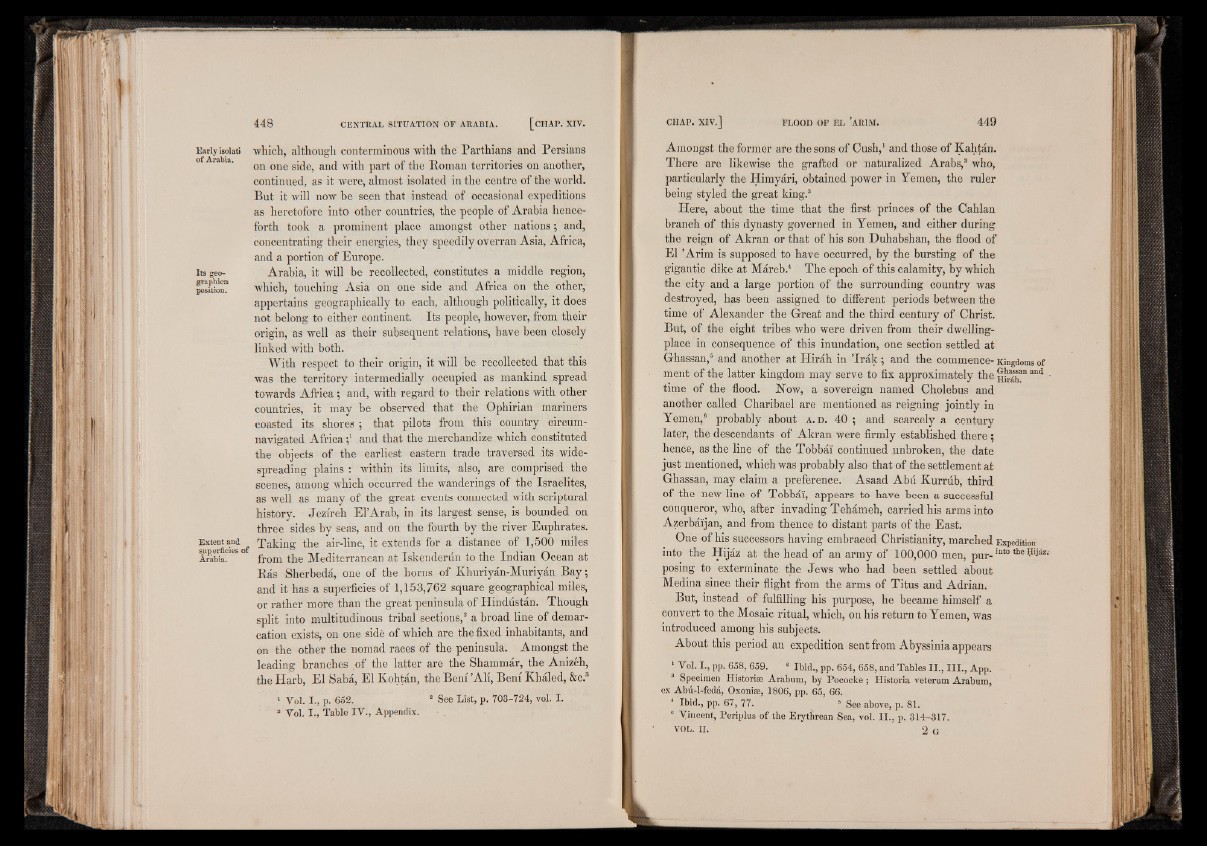
Early isolati
of Arabia.
Its geographica
position.
Extent and
sjiperficies of
Arabia.
which, although conterminous with the Parthians and Persians
on one side, and with part of the Roman territories on another,
continued, as it were, almost isolated in the centre of the world.
But it will now be seen that instead of occasional expeditions
as heretofore into other countries, the people of Arabia henceforth
took a prominent place amongst other nations; and,
concentrating their energies, they speedily overran Asia, Africa,
and a portion of Europe.
Arabia, it will be recollected, constitutes a middle region,
which, touching Asia on one side and Africa on the other,
appertains geographically to each, although politically, it does
not belong to either continent. Its people, however, from their
origin, as well as their subsequent relations, have been closely
linked with both.
With respect to their origin, it will be recollected that this
was the territory intermedially occupied as mankind spread
towards Africa; and, with regard to their relations with other
countries, it may be observed that the Ophirian mariners
coasted its shores ; that pilots from this country circumnavigated
Africa ;l and that the merchandize which constituted
the objects of the earliest eastern trade traversed its wide-
spreading plains : within its limits, also, are comprised the
scenes, among which occurred the wanderings of the Israelites,
as well as many of the great events connected with scriptural
history. Jezireh El’Arab, in its largest sense, is bounded on
three sides by seas, and on the fourth by the river Euphrates.
Taking the air-line, it extends for a distance of 1,500 miles
from the Mediterranean at Iskenderun to the Indian Ocean at
Ras Sherbeda, one of the horns of Khuriyan-Muriyan Bay;
and it has a superficies of 1,153,762 square geographical miles,
or rather more than the great peninsula of Hindustan. Though
split into multitudinous tribal sections,2 a broad line of demarcation
exists, on one side of which are the fixed inhabitants, and
on the other the nomad races of the peninsula. Amongst the
leading branches of the latter are the Shammar, the Anizeh,
the Harb, El Saba, El Kohtan, the Beni ’All, Beni Khaled, &c.3
1 Vol. I., p. 6S2. 2 See List, p. 703-724, vol. I.
3 Yol. I ., Table IV ., Appendix.
Amongst the former are the sons of Cush,1 and those of Kahtan.
There are likewise the grafted or naturalized Arabs,2 who,
particularly the Himyari, obtained power in Yemen, the ruler
being styled the great king.3
Here, about the time that the first princes of the Cahlan
branch of this dynasty governed in Yemen, and either during
the reign of Akran or that of his son Duhabshan, the flood of
El ’Arim is supposed to have occurred, by the bursting of the
gigantic dike at Mareb.4 The epoch of this calamity, by which
the city and a large portion of the surrounding country was
destroyed, has been assigned to different periods between the
time of Alexander the Great and the third century of Christ.
But, of the eight tribes who were driven from their dwelling-
place in consequence of this inundation, one section settled at
Ghassan,5 and another at Hirah in ’Irak; and the commence-Kingdoms of
ment of the latter kingdom may serve to fix approximately the ^ and •
time of the flood. Now, a sovereign named Cholebus and
another called Charibael are mentioned as reigning jointly in
Yemen,6 probably about a . d . 40 ; and scarcely a century
later, the descendants of Akran were firmly established there ;
hence, as the line of the Tobbai continued unbroken, the date
just mentioned, which was probably also that of the settlement at
Ghassan, may claim a preference. Asaad Abu Kurrub, third
of the new line of Tobbai, appears to have been a successful
conqueror, who, after invading Tehameh, carried his arms into
Azerbaijan, and from thence to distant parts of the East.
One of his successors having embraced Christianity, marched Expedition
into the Hijaz at the head of an army of 100,000 men, pur-mto 4110
posing to exterminate the Jews who had been settled about
Medina since their flight from the arms of Titus and Adrian.
But, instead of fulfilling his purpose, he became himself a
convert to the Mosaic ritual, which, on his return to Yemen, was
introduced among his subjects.
About this period an expedition sent from Abyssinia appears
1 Vol. I., pp. 658, 659. 2 Ibid., pp. 654, 658, and Tables I I , I I I ., App.
3 Specimen Histories Arabum, by Pococke; Historia veterum Arabum,
ex Abd-l-feda, Oxonise, 1806, pp. 65, 66.
4 Ibid., pp. 67, 77. 5 See above, p. 81.
6 Vincent, Periplus of the Erythrean Sea, vol. I I ., p. 314-317.
VOL. S 2 G